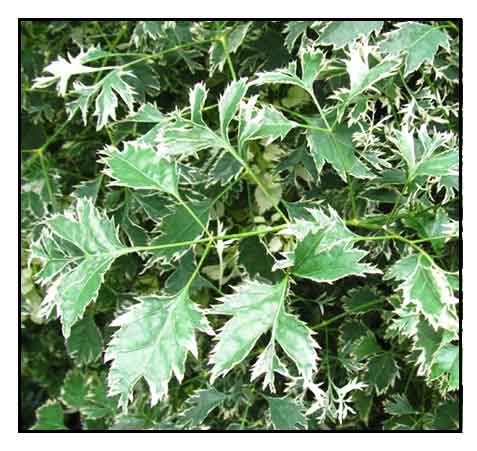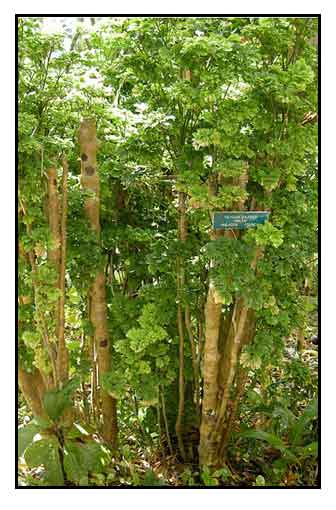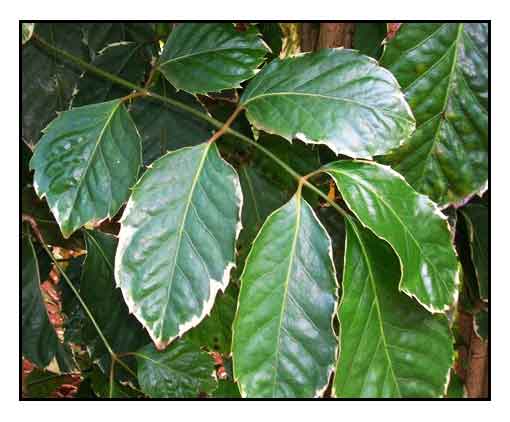 Gen info Gen info
- Polyscias is a genus of flowering plants in the family Araliaceae. As of 2022, Plants of the World Online recognizes 180 species in the genus. (15)
- Although referred to as "Wild coffee" it is not closely related to the true coffee plants of the genus Coffea. (16)
- The cultivar 'Victoriae", with strongly variegated, white and green, jagged leaves, is a recipient of the Royal Horticultural Society's Award of Garden Merit. (16)
- Etymology: The genus name Polyscias derives from Greek words ''poly' meaning much, and 'skia' meaning shade, referring to the thick foliage. The specific epithet guilfoylei honors English botanist William Guilfoyle, who made significant contributions to horticulture.
Botany
• Polyscias guilfoylei is an erect shrub that can grow to a height of 3 to 4 m, sometimes as high as 7 m.. Branches are erect and vertical. Leaves are alternate, up to 50 cm long, with 3 to 13 primary leaflets, 1-pinnate with leaflets arranged oppositely. Blades are variable, usually ovate or elliptic, coarsely dentate or lacerate. Leaves are sometimes entirely dark green, but commonly variegated, with white, creamy-white, or pale yellow margins. Inflorescence is a terminal cluster of thyrsoid panicles on a short rachis; flowers, rarely found, are externally bronze, pale within, petals 2.5 mm long and 1.2 mm wide. Fruit is trigonal, about 4 mm long and 5 mm wide.
• Shrubs or treelets, to 5 m tall, andromonoecious. Leaves 1-pinnate (irregularly decompound or 2- or 3-pinnate in some forms); petiole 7-18 cm, clasping at base, alate for 1.5-3 cm with membranous wings; petiolules 1-3.5 cm; leaflets (5-)7-9, often variegated, elliptic, ovate, or obovate, often broadly so, 5-20 × 2.5-12 cm, papery, base broadly cuneate to attenuate, margin spinulose-serrate, teeth (1-)1.5-5 mm, apex obtuse to broadly acute or acuminate. Inflorescence terminal, pendent, a panicle of umbels; primary axis 3-6 cm; secondary axes 5-10, scattered toward base, upper ones forming a terminal umbel, 20-60 cm; tertiary axes 8-12 per secondary axis, grouped in 1-3 verticils, (1.5-)3-12 cm; peduncles 1-2 cm, with a terminal umbel of bisexual flowers and often 1(or 2) lateral umbels of staminate flowers; pedicels 4-10 mm. Ovary 3- or 4(or 5)-carpellate; styles free nearly to base, recurving in fruit. Fruit rarely seen, subglobose, 4-5 mm high. (Flora of China)
Distribution
- Introduced.
- Ornamental cultivation.
- Commonly used as hedges and house plant.
- Native to Southeast Asia.
 Constituents Constituents
- Phytochemical screening of crude methanolic extract of leaves yielded tannins and saponins, with absence of carbohydrate, alkaloid, steroid, triterpenoid, and flavanoid. (see study below) (2)
- Hydrodistillation and GC-MS study of fresh leaves of Polyscias guilfoylei and P. balfouriana for essential oil yielded 42 compounds representing 79.17% and 87.77% of whole volatile constituents, respectively. Oxygenated sesquiterpenes represented 10.5% of volatile constituents of P. guilfoylei, with ß-chamigrene and y-muurolene as most dominant compounds. (see study below) (3)
- Gas chromatographic profiling of P. guilfoylei leaf oil identified 50 constituents; dominant compounds were ß-selinene 49.59%, α-selinene 21.68%, (Z)-falcarinol 11.65%. (see study below) (4)
- Study of leaf extracts isolated nine compounds: ent-labda-8(17),13-diene-15,18-diol (1), stigmasterol (2), spinasterol (3), N-(1,3-dihydroxyoctadecan-2-yl) palmitamide (4), panaxydiol (5), 3-O-β-d-glucopyranosylstigmasta-5,22-diene-3-β-ol (6), (8Z)-2-(2 hydroxypentacosanoylamino) octadeca-8-ene-1,3,4-triol (7), 4-hydroxybenzoic acid (8), and tamarixetin 3,7-di-O-α-L-rhamnopyranoside (9). (see study below)
(7)
- Study of aerial parts isolated three new oleanane saponins (1-3), along with four known ones (4-7). (see study below) (14)
- Study of P. guilfoylei aerial parts (defatted powdered mixture of leaves and stems) isolated three saponins: 3-O-[β-D-glucopyranosyl (1→3) β-Dglucuronopyranosyl-6`-methyl ester] oleanolic acid-28-O-methyl ester, 3-O- β-D- glucuronopyranosyl-6 ' -methyl ester oleanolic acid – 28 – O – β – D – glucopyranosyl and 3-O-*β-D-glucopyranosyl (1→3) β-Dglucuronopyranosyl-6 ' - methyl ester] oleanolic acid – 28 – O - β – D -glucopyranosyl ester. (18)
Properties
- Studies have suggested antioxidant, antimicrobial, anticancer, antiproliferative, histamine-inhibitory,
α-glucosidase inhibitory properties.
Toxicity concerns
-Toxicity: Reported toxicity to dogs, cats, and horses. Toxicity attributed to saponins, polyacetylene terpenoid falcarinol. Reactions may occur in the form of oral or skin irritation, buccal and throat swelling. (8) (12)
- The plant labeled with "low severity poison characteristics". Toxicity may manifest as contact dermatitis, vomiting, anorexia, depression. Toxic principle is attributed to saponin. (17)
Parts used
Leaves.
 Uses Uses
Edibility
- Caution: While toxicity is reported in dogs, cats, and horses. articles suggest the leaves are edible, rich in vitamin A, boiled and eaten like spinach. (see toxicity above) (13)
Folkloric
- No reported folkloric medicinal use in the Philippines.
- In Indonesia, boiled leaves drunk to treat urinary stones.
.(10)
- In Fiji, crushed leaves used to treat earache.
(11)
Others
- Ritual: In Fiji, liquid expressed from leaves is said to cleanse the spiritual attendant of a dead person. (11)
- Agroforestry: Used as ornamental hedge.
Studies
• Antioxidant / Antimicrobial / Leaves: Study evaluated the antioxidant and antimicrobial activities of crude methanolic extracts of P. guilfoylei leaves. Phytochemical screening yielded tannins and saponins. Total phenolic content of the ME was 10.36 mg gallic acid equivalent/g. Antioxidant activities of the extract against DPPH, H2O2m OH•radical were concentration dependent with IC50s of 1.88, 1.32, and 2.70 mg/ml, while ascorbic acid yielded 0.23, 0.28, and 0.23 mg/ml, respectively. At 5 mg/ml, the extract showed promising activity against S. typhi with ZOI of 10.0 mm, P. acne 9.3 mm and B. cereus 9.0 mm with chloramphenicol as positive control. Results suggest a promising source of natural antioxidants and antimicrobial agents. (2)
• Volatile Constituents / Antimicrobial / Essential Oil of Leaves: Hydrodistillation and GC-MS study of fresh leaves of Polyscias guilfoylei and P. balfouriana for essential oil yielded 42 compounds representing 79.17% and 87.77% of whole volatile constituents, respectively. Oxygenated sesquiterpenes represented 10.5% of volatile constituents of P. guilfoylei, with ß-chamigrene and y-muurolene as most dominant compounds. P. guilfoylei showed moderate activity against S. aureus (MIC 313 µg/ml) and Candida albicans (MIC 78.13 µg/ml). On cytotoxic activity using MTT assay on Caco-2 cell line, P. guilfoylei showed cytotoxicity with IC50 of 70.62 µg/ml. (3)
• Anticancer / Leaf Essential Oil: Gas chromatographic profiling of P. guilfoylei leaf oil identified 50 constituents; dominant compounds were ß-selinene 49.59%, α-selinene 21.68%, (Z)-falcarinol 11.65%. Anticancer activity of the leaf oil was tested by MTT, morphological observations, DNA ladder comet, caspase, flow cytometry and in-vivo assays. Results showed the P. guilfoylei leaf oil, with minimal toxicity to normal cells, exhibited significant anticancer activity against lymphoma cells.(4)
• Stimulation of Phenolic Production / Antioxidant / Cytotoxicity / Shoots: Study reports on a method to enhanced phenolic compounds production in in-vitro cultured shoots. Shoots were treated with methyl jasmonate (JM) or salicylic acid (SA). The elicitors significantly enhanced phenolic production compared to untreated shoots. Chlorogenic acid was the most abundant compound with yield of 5.03 mg/g DW after treatment with 50 µM SA. Extracts from JM and SA treatments reduced cancer cell viability and increased their mortality. Study also showed plant phenolic compounds in combination with anticancer drugs could reduce the detrimental effect of the latter on human cells. .(6)
• Histamine-Release Inhibition / Cytotoxicity / Antibacterial / Leaves: Study of leaves isolated nine compounds. The leaf extract and compounds 5 and 9 exhibited weak cytotoxicity against both MCF-7 and HCT-116 cell lines. The leaf extract showed activity against E. coli with with MIC of 9.76 µg/ml. Compound 4 showed promising inhibition of histamine release using U937 human monocytes with IC of 38.65 µg/ml. (see constituents above) (7)
• Antiproliferative Oleanane Saponins / Aerial Parts: Study of aerial parts isolated three new oleanane saponins (1-3), along with four known ones (4-7). The compounds were evaluated for antiproliferative activity using three murine and human cancer cell lines: J774.A1, HEK-293, and WEHI-164. All compounds were inactive except for compound 3, 3β-O-[β-D-glucopyranosyl-(1→2)-α-L-arabinopyranosyl]-echinocystic acid 28-[O-β-D-glucopyranosyl-(1→6)O-β-D-glucopyranosyl] ester, which was active against all the cell lines. (14)
• α-Glucosidase Inhibitory / Antioxidative / Stems: Study of Polyscias guilfoylei stems isolated 11 constituents, including a nucleoside uracil (1), two sterols β-sitosterol (2) and daucosterol (3), a saponin androseptoside A (4), two lignans (+)-pinoresinol (5) and (+)-syringaresinol (6), four phenolic acids protocatechuic acid (7), methyl protocatechuate (8), caffeic acid (9), and 5-O-caffeoylquinic acid (10), and a flavonoid quercitrin (11). Phenolic compounds 7 and 9 showed IC50s of 21.33 and 13.88 µg/mLin DPPH antioxidative assay, compared to resveratrol control IC50 of 13.21 µg/mL. In
α-glucosidase inhibitory assay, sterols 2 and 3 and flavonoid 11 induced IC50s <2.0 µg/mL, better than positive control acarbose with IC50 of 184.0 µg/;mL. Results showed compounds 2, 3, and 11 bind relatively stronger with C-terminal domain than N-terminal domai8n through pivotal residues in the binding site and can be hypothesized as mixed inhibitors. (19)
Availability
Wild-crafted.
Plants in the cybermarket. |

![]()






